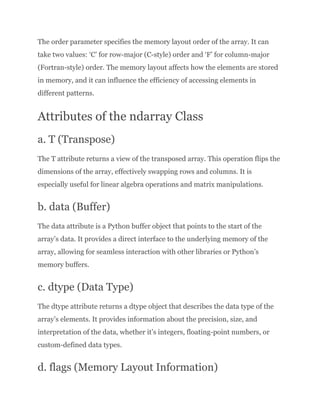Numpy ndarrays are n-dimensional, homogeneous arrays that provide an efficient way to store and manipulate large multi-dimensional datasets. They are the fundamental data structure in NumPy that enables working with homogeneous data. An ndarray is created with a shape that defines its dimensions and a data type that specifies the type of data elements. It supports common operations like arithmetic, indexing/slicing, aggregation, reshaping and transposing. NumPy ndarrays are an essential tool for numerical computing and data analysis in Python.
![Numpy ndarrays
One of the fundamental components of NumPy is the ndarray (short for
“n-dimensional array”). The ndarray is a versatile data structure that enables
you to work with homogeneous, multi-dimensional data. In this guide, we’ll
dive deep into understanding ndarray, its structure, attributes, and
operations.
Introduction to ndarrays
An ndarray is a multi-dimensional, homogeneous array of elements, all of the
same data type. It provides a convenient way to store and manipulate large
datasets, such as images, audio, and scientific data. ndarrays are the lynchpin
of many scientific and data analysis libraries in Python.
Creating ndarrays
Follow TechVidvan on Google & Stay updated with latest
technology trends
Using numpy.array()
The numpy.array() function allows you to create an ndarray from an existing
list or iterable.
import numpy as np
data_list = [1, 2, 3, 4, 5]
arr = np.array(data_list)](https://image.slidesharecdn.com/numpyndarrays-230916042623-6f6fc4eb/85/Numpy-ndarrays-pdf-1-320.jpg)





![The ctypes attribute provides an object that simplifies the interaction of the
array with the ctypes module, which is useful for interoperability with
low-level languages like C.
n. base (Base Array)
The base attribute returns the base array if the memory is derived from some
other object. This is particularly relevant when working with views or arrays
that share memory with other arrays.
Indexing and Slicing
You can access elements within an ndarray using indexing and slicing.
Advertisement
arr = np.array([[1, 2, 3], [4, 5, 6]])
print(arr[0, 1]) # Output: 2 (element at row 0, column 1)
print(arr[:, 1:3]) # Output: [[2, 3], [5, 6]] (slicing columns
1 and 2)
Array Operations
Element-wise Operations
ndarrays support element-wise operations like addition, subtraction,
multiplication, and division.
arr1 = np.array([1, 2, 3])
arr2 = np.array([4, 5, 6])
result = arr1 + arr2 # Element-wise addition
print(result)](https://image.slidesharecdn.com/numpyndarrays-230916042623-6f6fc4eb/85/Numpy-ndarrays-pdf-7-320.jpg)
![Output:
[5 7 9]
Broadcasting
Broadcasting allows arrays with different shapes to be combined in
operations.
arr = np.array([[1, 2, 3], [4, 5, 6]])
scalar = 2
result = arr + scalar # Broadcasting scalar to all elements
print(result)
Output:
[[3 4 5]
[6 7 8]]
Reshaping and Transposing
You can reshape and transpose ndarrays to change their dimensions and
orientations.
arr = np.array([[1, 2, 3], [4, 5, 6]])
reshaped_arr = arr.reshape((3, 2)) # Reshaping to 3x2
transposed_arr = arr.T # Transposing the array
print("Original Array:")
print(arr)
print("nReshaped Array (3x2):")
print(reshaped_arr)](https://image.slidesharecdn.com/numpyndarrays-230916042623-6f6fc4eb/85/Numpy-ndarrays-pdf-8-320.jpg)
![print("nTransposed Array:")
print(transposed_arr)
Output:
Original Array:
[[1 2 3]
[4 5 6]]
Reshaped Array (3×2):
[[1 2]
[3 4]
[5 6]]
Transposed Array:
[[1 4]
[2 5]
[3 6]]
Aggregation and Statistical Functions
NumPy provides numerous functions for calculating aggregates and statistics.
arr = np.array([1, 2, 3, 4, 5])
mean = np.mean(arr)
median = np.median(arr)
std_dev = np.std(arr)
print("Array:", arr)
print("Mean:", mean)
print("Median:", median)](https://image.slidesharecdn.com/numpyndarrays-230916042623-6f6fc4eb/85/Numpy-ndarrays-pdf-9-320.jpg)
![print("Standard Deviation:", std_dev)
Output:
Array: [1 2 3 4 5]
Mean: 3.0
Median: 3.0
Standard Deviation: 1.4142135623730951
Boolean Indexing and Fancy Indexing
Boolean indexing allows you to select elements
based on conditions.
arr = np.array([10, 20, 30, 40, 50])
mask = arr > 30
result = arr[mask]
Output: [40, 50]
Fancy indexing involves selecting elements using
integer arrays.
arr = np.array([1, 2, 3, 4, 5])
indices = np.array([1, 3])
result = arr[indices]
Output: [2, 4]
Conclusion](https://image.slidesharecdn.com/numpyndarrays-230916042623-6f6fc4eb/85/Numpy-ndarrays-pdf-10-320.jpg)
